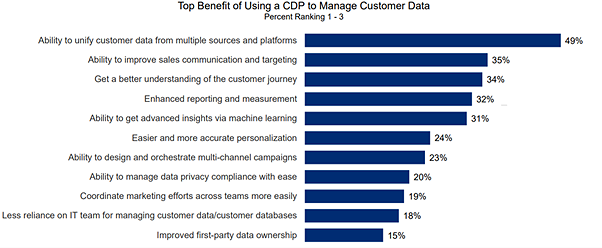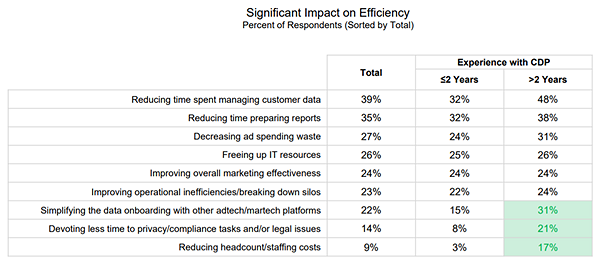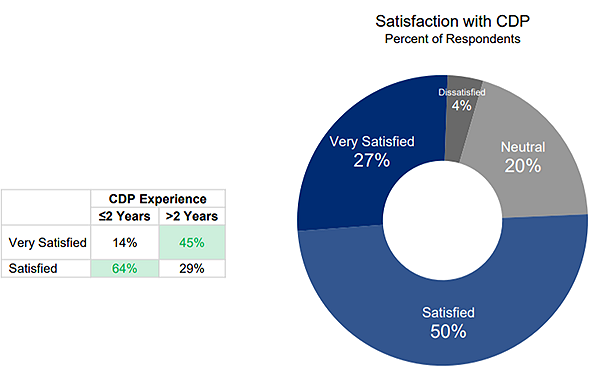As a mid-sized company, there will be many areas where a Customer Data Platform (CDP) may add value to your business.
Your company will most likely have an existing range of marketing technology solutions, such as an email service provider (ESP), an ecommerce platform linked to your website, Google Analytics, and an offline order processing system which maintains a history of all product sales through different fulfilment channels.

Before deciding on whether a CDP can improve on what you already have, there are some key questions you need to ask.
What actual value will we gain by adding in a CDP to our normal configuration of tools?
A CDP will normally provide additional core functions including:
- Ingesting data from your website, email service provider, ecommerce system and order processing
- Identity resolution to pull together all known data about every customer or prospect sourced online or offline
- Data integration, often via API, with other existing martech tools
- Building a single customer view to include a mix of raw data received and derived data variables
- Capability to automate trigger or batch marketing campaign selections
- Provision of dashboards based on the data received
- Campaign results reporting or even multichannel marketing attribution
What is the role of a CDP in supporting our marketing and business planning decisions?
A CDP will be able to answer a wide range of planning questions, including:
What longer term customer value (LTV) can we expect when we recruit customers from various sources, or through different offers?
Invariably different recruitment channels will provide customers with varying LTV and understanding these enables the business to set realistic CPA targets by channel.
What proportion of my existing customers reorder each year and how much is that worth?
This key question allows a marketer to plan forward knowing broadly how much demand is to be expected before new customer recruitment is added in. It also enables a company to measure how well their overall customer marketing is doing. If the percentage of existing customers reordering is growing, then customer marketing is doing a good job, but if it’s falling something needs fixing.
What value am I getting back from my marketing investments?
Because the CDP can track customer journeys, both online and offline, it can measure the contribution made by specific campaigns or channels to these, and hence their value provided. No longer should a marketer simply take a list of people contacted by a campaign and find out which of these have ordered in a specific time period, because this will ignore all the other components of the customer journeys that led up to a sale.
Are there areas of my marketing spend that should be cut back or removed?
Most companies hang on to some campaigns that should be modified, but often lack the analytical tools to identify them. A frequently found example is spend on PPC where GA is reporting a much-exaggerated contribution, but without the capability to look at all the other elements in the customer journey, the PPC spend is maintained. Another example is where data is purchased to run cold campaigns. A cold list needs to be integrated into the CDP to support the full evaluation of the campaign just as contacts made with existing customers do.
On a much wider basis companies need dashboards to show them the direction of travel across a whole range of KPIs. These can look at anything from how different customer segments are performing, to the proportion of successful vs. unsuccessful website visits. The data in the single customer view, particularly because it combines both online and offline activities, can provide a very rich feed for dashboard reporting using tools like Power BI or Tableau.
The CDP can be seen as a rich historical data store that holds a persistent record of the activities of each customer. From an analytical perspective this is invaluable as the data can be mined by data-scientists to answer every conceivable question relating to sales, customers, marketing performance and even where profit ultimately comes from.
And finally, the CDP allows for the democratisation of data and information. CDPs are normally cloud based, and hence open to anyone with access rights. This means not only access to dashboards, and existing metrics reports, but also the ability to extract data and undertake further analysis as required.
How can we generate more value from existing customers or prospects?
There are many ways in which the CDP can improve cross-channel communications, and hence improve value received from customers.
- The capability to respond to triggers is critical to delivering the right communication at the right time. There is some capability to do this embedded inside many of the ESP platforms, but because they lack the richness of data contained in the SCV, they can on the whole only respond to short-term signals like dropped baskets. A CDP will be able to take the wider view, for instance understanding the longer-term value of the individual customer, whether they are becoming more or less loyal to the brand, whether they have missed their usual anniversary of making a purchase, the kind of merchandise they are likely to buy based on their affluence, the behaviour of other customers in their household, and so on. The list of potential trigger activities based on a CDP is huge and a brainstorm to surface these can be invaluable.
- In a related way the CDP can target batch campaigns in a very sophisticated manner. For instance, not only can overall response propensity models be built that are far more powerful than RFM (recency, frequency, monetary value) selections, but also these can be used to determine which categories of product an individual customer is more likely to be more interested in.
- We often find companies ignoring large swathes of customers who have not ordered for a while, which, when using RFM selection methodologies, they are not able to target economically. However, once a reactivation propensity model has been built, groups of these individuals can be identified that are very profitable to reactivate.
- Introducing customer segmentations to determine the types of propositions to make to individuals. Take a very basic segmentation based on age and affluence and it becomes immediately clear how useful is a tool like this. It can be applied to the SCV and used to differentiate the content being used for different groups so that the affluent older generation can be treated differently to impoverished students.
- The CDP can be used to manage customer contact density across all outbound channels and to coordinate the messaging. When they are operating in different silos the ESP can send message A and the direct mail campaign can contradict it with message B. The CDP can remove these kinds of contradictions and also manage the overall level of communications sent to individuals. Send out too much and you are not only wasting money, but also drowning the customer, whilst sending too little means that you will be missing potential demand and leaving the customer curious about what they have not been offered. Our testing has also found that different customer segments, particularly those based on different propensities to buy, will respond better to varying levels of contact density.
- Lastly, there is the crucial question of using testing and setting up control groups. A CDP can be used to set up control groups who, for instance, are not exposed to any marketing communications from any channel and contrast these with those that are. Testing also provides the knowledge base from which every kind of improvement in customer communications can be derived. But tests need to be selected from, and recorded in, the SCV to avoid cross-channel confusion and provide the ability to measure the longer-term consequences of the tests, rather than just the short-term response from a particular offer.
How do we reduce the time spent on managing campaigns and pulling reports?
The CDP will create one version of the truth for the business, from which consistent compliant selections and reliable automated reports can be produced.
- There is a huge amount of drudgery in managing marketing communications if you don’t have the right tools. With a well-designed CDP, and using drop down menus, setting up a new campaign should be a matter of minutes, compared with what many hours if different data sets need to be combined, manual selections made, seed lists added in, and source codes applied, etc.
- If your CDP is linked to a suppression house you can also, with a click, send your selection to have the goneaways and deceased flagged in seconds.
- At the same time as setting up the campaign you will be able to organise how its results are reported and choose the right metadata to describe it. After that reporting and test results comparisons should be automated.
- Ad hoc reporting is normally the elephant in the room when it comes to workload and much of this can be eliminated by having in place the right set of dashboards, plus automated customer and campaign metrics.
- Some CDPs will automate many aspects of GDPR requirements, including the coordination of consents and automating the production of Subject Access Requests. Consent coordination is vital for campaign management and again can avoid considerable manual effort.
- When looking at the benefits from introducing a CDP, the financial value of marketers’ time saved may seem small compared with the other benefits, but the improvement in accuracy, creativity and job satisfaction released by the removal of boring manual tasks can be very important.
How do we make a decision about whether to introduce a CDP?
There are a large number of areas where a CDP may be able to add value to your business. However, there is no substitute for brainstorming, and then listing, all the potential use cases and working out the value you will expect to get back from each of them. The benefits usually take the form of increased customer value, reduced marketing costs and saving of staff time.
There is also the important question of what impact this will have on your internal IT resources. The answer to this is relatively simple. Assuming that all the data feeds can be automated, once these have been set up to run your internal IT team will have done their job, assuming you are buying a fully serviced CDP.
If you are buying a platform that you will need to configure yourselves, then there is an additional layer of work which may be substantial. It is critical to find out from the vendor exactly how much support you can expect to get.
Research has shown that most companies who introduce a CDP get considerable value from them, but that this augments over time. As the users learn how to get more and more value from the CDP, so the returns grow. So, it is worth lowering expectations for year one, and augmenting them for subsequent years.
UniFida can help with use cases for a CDP:
Request a no-cost Proof of Concept

UniFida is the trading name of Marketing Planning Services Ltd, a London based technology and data science company set up in 2014. Our overall aim is to help organisations build more customer value at less marketing cost.
Our technology focus has been to develop UniFida. Data science business comes both from existing users of UniFida, and from clients looking to us to solve their more complex data related marketing questions.
Marketing is changing at an explosive speed. Our ambition is to help our clients stay empowered and ahead in this challenging environment.







